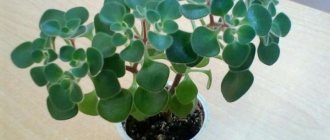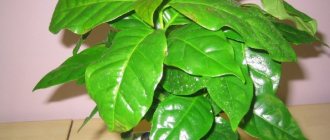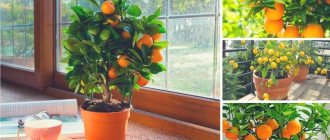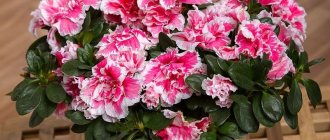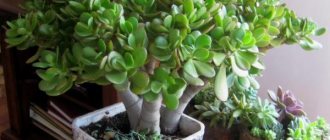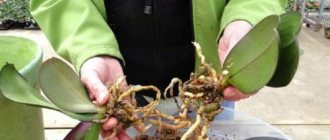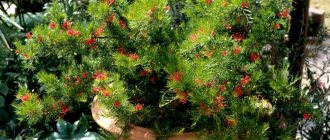This time we are sharing secrets on how to grow a coffee tree from a grain (seed) or cutting. This fragrant plant will become an exotic decoration for your home greenhouse. It is grown as a decorative element or for its fruit. The shape of the plant resembles a low bush. It is regularly trimmed and fed with mineral preparations. In comfortable conditions and proper care, about 500 g of fruits are collected from one tree.
Where are the plantations?
Coffee plantations are located in equatorial countries. The trees grow on the African continent, Madagascar, Central and South America, southeast Asia, and Australia.
Coffee trees do not do well in the constant heat of tropical climates. Therefore, they are planted on high mountain slopes with soil of volcanic origin. The optimal height is 1-2.5 thousand m above sea level.
Exposure to the scorching sun is detrimental to plantations. Therefore, in addition to coffee plants, tall trees with a dense crown are planted. Read more in the article “Where Coffee Really Grows.”
Main types of trees
Arabian
The variety is used in coffee growing as an ornamental plant. The tree has oblong dark olive leaves with a glossy surface. Their size reaches 30 cm.
If the tree is grown indoors, it is regularly trimmed so that it does not rest against the ceiling. The optimal height is 1.4 meters. On plantations this variety grows up to 5 meters.
Flowers appear only in the 4th year of life. The tree begins to produce its best harvest at 7-8 years of age.
The Arabian tree grows actively in spring and summer. Every year it grows by 8-10 cm.
Dwarf nana
This tree grows only up to 1 meter, so it is suitable for apartments and private houses. Dwarf nana blooms profusely and is unpretentious to its conditions. Leaves with light veins grow up to 15 cm.
The crown is trimmed annually to give the coffee tree a decorative appearance.
Small white flowers develop into terracotta-colored fruits. During the season, up to 0.5 kg of fruits are collected from dwarf nana.
The tree grows well in high humidity and does not tolerate drafts.
Liberian
Due to its size, this variety is rarely used for growing indoors. At home, the coffee tree reaches 4 meters and feels good on the windowsill.
The crown has to be trimmed constantly. Otherwise, the leaves will prop up the ceiling and the plant will lose its decorative effect.
Botanical characteristics
Magnificent inflorescences of the coffee tree.
The coffee tree is a compact tree. The average height of the plant is about 5 meters. In a container, the length can be easily adjusted by periodic trimming. The tree is distinguished by dark green, ribbed leaves with a silvery tint. The plant blooms twice a year in its native subtropical conditions.
When grown as a houseplant in cold climates, house trees will bloom only in the summer and spring. The entire plant will be covered with small snow-white flowers with a sweet jasmine scent. The crop will begin to produce inflorescences in the second or third year of cultivation.
Then small fruits will appear on the plant, which are initially green. The shade will transform into a red tint. Ripe fruits can decorate the plant for several months. The fruit does not soften and will not spoil. Future coffee beans will dry out.
Coffee varieties
Arabica
The most common variety of coffee tree.
The plant is demanding to care for, needs diffused sunlight and moderate moisture.
In nature, the tree grows up to 10 meters. But for convenient collection of beans it is cut to 4 meters
Arabica does not tolerate cold. Therefore, the tree is grown at a temperature of at least 15 degrees Celsius.
The Arabica drink has a sour taste. The bean contains 1.5% caffeine.
Robusta
The Robusta coffee variety is unpretentious in terms of content. It grows at temperatures down to 0 degrees and tolerates heat well. Another advantage is resistance to pests.
Interesting! How to grow Arabic coffee in a room - characteristics of the plant, and methods
Up to 1.5 kg of beans are collected from one tree (0.9 kg from Arabica).
Robusta has a pronounced bitter taste. Therefore, grains of this variety are added to mixtures. Mono varieties are rare.
Robusta beans contain about 3% caffeine.
Liberica
Less popular variety due to low taste. Liberica is mainly used to make coffee blends and instant coffee. It is also used in the manufacture of confectionery products.
Of the total volume of coffee trees grown, only 2% is Liberica.
Trees do not do well in drought and high humidity. If there is prolonged bad weather, the tree stops bearing fruit.
This variety is resistant to diseases and insect pest attacks.
Liberica beans contain up to 2.4% caffeine and are three times longer than Arabica beans.
Excelsa
Excelsa is a type of liberica. It easily tolerates heat and high humidity, but is demanding on the composition of the soil. This variety needs moist soil with a rich organic composition.
The trees reach a height of 20 meters.
The brewed drink has a fruity smell and a chocolate-nut taste with hints of sourness. Excelsa is added to elite coffee varieties.
One bean contains up to 1.5% caffeine.
How to care
The coffee tree is quite easy to care for. Even a novice gardener can grow a specimen with bright greenery.
Important nuances that experienced flower growers pay attention to:
- Water and spray with filtered warm water.
- The air temperature should be no lower (+22°C), and humidity 70–80%.
- Apply fertilizer twice a month.
- In the autumn-winter period it is necessary to use ultraviolet lamps.
- In the summer, it is advisable to take it out into the fresh air (in the garden, balcony, veranda).
- It is undesirable to rearrange or move the flowerpot with the plant without the need.
- Pruning is done as desired to make the crown thicker.
Location
It is recommended to place the plant on the south side; a room with access to similar directions is also suitable: southwest or southeast. The north window will not provide enough sunlight, you will have to additionally illuminate it with a lamp. In summer it is necessary to shade it from direct sunlight to avoid burns on the leaves.
Temperature
For good growth and fruiting, the plant needs: temperature +22…+25°C. In winter, the air should not cool down to +12...+13°C, this has a detrimental effect on the flower. If necessary, the ornamental plant is transferred to a heated room.
Lighting
The plant is light-loving. If there is insufficient lighting, the exotic tree does not bloom, grow, or bear fruit well.
It is advisable to place the coffee tree in rooms where there is a lot of light: south or southeast. In summer, shade from exposure to direct sunlight.
If the windows face north, additional lighting is necessary, otherwise the flower may wither due to lack of light. LED lamps or fluorescent lamps are used as artificial lighting.
Watering and humidity
Important points:
- The coffee tree prefers high humidity, as well as air temperature (+25°C).
- Water and spray with settled warm water; in the spring-summer period, they are guided by the dryness of the earthen clod.
- In winter, the substrate is moistened at intervals of three to four days, but the greens must be irrigated every day.
- Water stagnation is not allowed to prevent the root system from rotting.
Fertilizers and fertilizers
For abundant flowering and fruiting, fertilize with liquid fertilizers (mineral or organic).
In summer, nutrition must be increased: active growth occurs, flowers appear, fruits ripen.
The following are used as mineral fertilizers:
- nitrogen (ammonium sulfate, urea, sodium nitrate) – promotes the growth of stems and foliage;
- potassium (potassium magnesium or potassium salt) – increases resistance to disease and increases the quality of buds and coffee beans;
- phosphorus (ammophos, superphosphate, diammophos) – strengthens roots, improves flowering and fruiting.
Nitrogen fertilizers are used only in the spring, and phosphorus-potassium fertilizers are used in the summer and autumn months. In winter, it is not recommended to feed the plant.
Organic fertilizers include:
- rotted compost (contains potassium, phosphorus and nitrogen);
- peat (replaces nitrogen);
- ash (analogue of potassium).
Nutrients are applied to moist soil in liquid form once every 14 days. The best option is to use natural products and organic matter.
Pruning and crown formation
The plant forms a crown on its own; pruning is needed only when the tree has grown too tall. You can pinch the top branches, this will allow the side stems to grow.
Transfer
The tree is replanted after the seeds have sprouted and the cuttings have formed roots, when the plant has little space in the pot (the roots are visible from the drainage holes).
Basic Rules:
- prepare the soil;
- select the pot size;
- place drainage at the bottom of the container;
- carefully remove the plant from the old pot;
- inspect the root system;
- transferred to a new flowerpot, planted;
- water with warm, soft water;
- It is enough to replant an adult plant once every 3 years, and a young one every year.
Visual video - instructions for transplanting a coffee tree:
Reproduction
Process Features:
- There are two proven methods: propagation of an exotic tree using grains and cuttings.
- Take green seeds.
- If propagated by shoots, then it is necessary to cut off the stem with 4–6 leaves.
- Stimulate them with phytohormones, and additionally scarify the seeds.
- Plant the grain with its flat side in moist soil and deepen it 1 cm into the soil.
- The cuttings are planted to a depth of 2 cm, greenhouse conditions are created: temperature - about +25 degrees, humidity - 70%.
- A month later, a sprout appears, and the shoot has new leaves and a formed root.
- The grown bush is transplanted into a new flowerpot.
Soil preparation
You can only grow coffee at home in suitable soil. The optimal composition is perlite and peat.
A mixture of river sand, ground peat and leaf turf in proportions of 2:2:1 is also suitable. Or an equal amount of humus, leaf turf, sand, black soil and two parts of acidic peat.
Mix the ingredients in the required proportions and pour into a small container.
Do not compact the soil too hard. It must be loose so that air gets to the root system.
Add finely chopped sphagnum moss. It retains moisture and maintains soil acidity.
Be sure to install drainage at the bottom of the pot. When loose soil is watered, the water moisturizes the roots well and does not stagnate. The excess will drain into the pan, so the roots will not rot if there is excessive moisture.
Before planting the cuttings, the soil is disinfected with a weak solution of potassium permanganate.
Growing from cuttings
Getting ready for planting
Now let’s talk about how to grow a coffee tree from a green cutting at home.
Using a sharp knife, cut a branch from the middle of the crown of an adult coffee tree 3 cm below the leaves. Take a cutting with flower bud embryos. Such a plant will begin to branch and bloom faster.
On the trunk, under the two outer leaves, make longitudinal scratches so that the roots form faster.
For better growth, the cuttings are first left for 3-4 hours in a growth stimulator. A heteroauxin solution is suitable. Dissolve 1/4 tablet of the drug in 1.5 liters of water. But do not submerge the branch completely. It is enough to lower it by 1-1.5 cm.
Heteroauxin can be replaced with indolyl-3-butyric acid. 25 ml of the drug is diluted in 0.5 liters of water. The cuttings are immersed 1 cm and left in the solution for 16 hours.
A solution of 1 tsp is also suitable. honey and 200 ml warm water.
The twig is soaked and then planted in a small container with prepared soil.
To keep the soil always moist, create a greenhouse effect using a plastic bag. Make holes in it for air access.
Transplant into a pot
The cuttings are transplanted into a permanent pot after new leaves have formed. At this moment, the plant begins to form a root system.
Interesting! How many spoons of coffee should I put in a cup?
The optimal humidity for rooting is 75-80%, temperature is 28-30 degrees Celsius.
After transplanting, water the plant and keep an eye on it. If the cutting has taken root, after 2 weeks move the pot to a permanent place.
A coffee tree grown from a cutting begins to bear fruit within a year after planting.
How coffee beans are grown
We recommend growing the tree from fresh seeds. They grow in 95% of cases. If the beans have been stored for several months, the chances drop to 2-3%.
Make a deep cut in the outer shell of the seed to help it germinate faster.
Before planting the coffee bean, put it in a growth stimulator overnight (we talked about them above). And in the morning, plant the seeds in loosened, slightly moist soil to a depth of 4 cm. The distance between the seeds should be 3 cm.
Water the soil with cool water and cover with a jar or plastic to create a greenhouse effect. Place the pot in a warm place.
Every two weeks, open the pot and remove any condensation. After 1-1.5 months, the planted seed will hatch and the sprouts can be transplanted into separate containers.
After a month, the coffee seeds are transplanted into a larger container.
A tree made from grains will bloom only 2-2.5 years after planting. The first grains will appear after 4 years.
Planting a coffee tree from beans
To start growing a coffee tree with your own hands, you need to prepare a deep pot so that the tap root is comfortable and free. The grain must be lightly compressed with pliers or cut deeply with a knife so that the outer shell cracks. Then germination will begin faster. Otherwise, the grain will not be accepted until its outer shell has decayed.
The next procedure is as follows:
It is better to choose fresh seeds. They are more likely to germinate. But from seeds that have been lying around for a long time, only 2-3 out of 100 can begin to grow.
Tree care
Temperature and light
The coffee tree does not tolerate the lack of sunny color. The trunk will be overgrown with a lush green crown, but will not bear fruit.
The ideal place is a windowsill. Choose the south or east side. On the north window the tree grows slowly.
Due to constant exposure to sunlight, burns may appear on the leaves. When fruit appears, shade the plant with a curtain or fence.
In winter, eliminate drafts and seal cracks in windows.
The temperature should not fall below 15 degrees and exceed 25 degrees.
Watering
Water the coffee on the windowsill with settled water at 20-25 degrees.
In summer, the soil dries out quickly, so you need to water it every day. In winter, the plant is watered once a week.
Do not flood the growing plant with water. If dark spots appear on the leaves, reduce the amount of watering. Dry ends indicate lack of water and low humidity.
Pour 3-4 drops of apple cider vinegar into your water every month. This will keep the soil acidic for rapid plant growth.
Twice a week, spray the tree with cool water from a spray bottle and wipe the leaves with a damp cloth.
Once every 1-1.5 months, give the coffee tree a warm shower. But the pressure should not be strong.
Top dressing
When growing coffee at home, fertilizers are used. From April to September, during flowering, mineral supplements are added every 15 days.
Use complex preparations for decorative foliage plants. An infusion of cow manure or chicken manure is also suitable.
Fill half a bucket with barn or chicken excrement. Pour cool water to the top, stir well. Cover the bucket with a lid and leave to ferment for 2 weeks.
Then dilute the fertilizer with water in a 1:1 ratio and water the plant.
In late autumn and winter, the tree is not fed. It is at rest and resting.
Once every 1-1.5 months you can enrich the soil with liquid potassium for nutrition. Highly concentrated potassium sulfate fertilizer is suitable.
Do not exceed the dosage indicated in the instructions. Excessive amounts of fertilizer will harm the plant.
Transfer
When growing coffee, the tree is transplanted into a larger pot every March-April.
Interesting! How to grow a coffee tree at home from coffee beans
After four years, the active growth of the plant slows down. Transplantation is carried out no more than once every 2-3 years.
Each time the diameter and size of the pot increase. Let's look at examples:
- a tree 40 cm tall is planted in a container 25 cm high and 24 cm in diameter;
- 50 cm - 35 cm by 35 cm, respectively;
- 100 cm - 60 cm by 60 cm.
Do not plant the tree in a low pot like a bonsai. The root system will be crowded.
Trimming
Domestic trees have to be pruned. Otherwise they will grow too tall and will prop up the ceiling.
Dry and weakened branches that shed leaves are also pruned. They only slow down the growth of the tree.
Typically, crown pruning is carried out only at the 8-9th year of the plant’s life.
Suitable temperature, humidity and lighting for coffee
For normal development of a seedling, it requires the following air temperature:
In winter, the temperature in the home should not fall below +12 degrees, because if the temperature is lowered, the growth of the young green pet is inhibited and its roots rot. Not entirely comfortable conditions are quite suitable for an adult plant to overwinter. The acceptable temperature for it in the winter season is +10 degrees, it definitely needs good lighting and a little infrequent watering of the root zone.
The seedling loves it when its leaves are regularly sprayed with settled, warm water. This procedure is carried out at all times of the year. The home coffee tree should grow in moderately humid air. If it is dry or excessively wet, it inhibits the plant.
The growth of the seedling on the northern window will be long, flowering will be late, and fruiting will be delayed. Southern lighting also has its drawbacks. The leaves of the coffee tree can easily get sunburned, so in the summer season the plant is slightly shaded. To do this, attach a sheet of newspaper to the glass of the window with tape. The rays of the sun falling on the coffee, becoming scattered, do not burn the leaves.
If there is no good sunlight, then the adult “green resident” cannot form a full-fledged ovary. We must not miss the moment when the flower cluster forms fruit embryos; after this process, the plant must be shaded.
Diseases and pests
Reasons for appearance
When attacked by pests, the tree begins to wither. The plant is not protected from them even indoors. The ends of the leaves darken and holes form on them.
The reasons for the appearance of insects are poor-quality soil and dirty equipment. Pests fly into the apartment through windows, cracks, and ventilation holes.
Spider mite
The most common insect is the spider mite. It can completely destroy the plant.
Tiny insects cling to the undersides of the leaves. They are noticeable even with the naked eye.
In the early stage, the leaves become covered with small holes. The plant is then entangled in a web.
Optimal conditions for ticks are low humidity and sunny weather.
The tree is sprayed with a cool solution of organic soap 3-4 times a day. Chemicals are used every three days:
- "Neoron";
- "Fitoverm";
- "Anti-mite."
When processing, do not allow drugs to come into contact with the fruits.
Aphid
When attacked by aphids, the leaves of the tree curl. Tiny punctures with a diameter of 2 mm and a transparent trace of pest secretions appear on them. They pierce the leaves and suck out the juice.
Aphids breed in dry and warm rooms. If pests are found, wipe each leaf of the plant with a piece of foam rubber soaked in a soap solution.
If there are too many affected leaves, treat the tree with chemicals - Atorin, Aktara.
Aphids quickly adapt to the composition, so do not use the same preparation twice.
Whiteflies
Tiny white insects live under the top leaves of the tree. They slow down the production of chlorophyll and stop plant growth. A sugary stain appears on the leaves, whiteflies and their larvae are visible.
It is very difficult to get rid of the larvae. They are not affected by purchased chemicals and homemade poisons.
If the leaf is half affected, it will have to be cut off. The plant is treated with a soap solution, garlic infusion, and dichlorvos.
